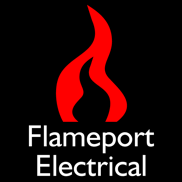Old Electrical Equipment - Old BILL Insulok double pole fusebox
Ceramic fusebox with a moulded cover, fixed to a wooden backplate. This example was removed from a property in August 2010.
Closed view
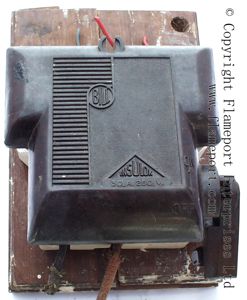 This is how the box would appear when installed. The cover fixings are actually broken, and when in use, the cover was just laying on the floor.
This is how the box would appear when installed. The cover fixings are actually broken, and when in use, the cover was just laying on the floor.
Rating 250V, 30A. Isolator switch located at the right side, shown here in the OFF position.
The two wires at the bottom are the supply, one black for neutral and one red for live. These are rubber insulated with a cotton overbraid and at least 60 years old. They were connected directly to the electricity meter with no additional fusing or isolation.
Cover removed
 Front cover removed. This is actually how the box looked in the installation. Note the blade type switch contacts are completely exposed.
Front cover removed. This is actually how the box looked in the installation. Note the blade type switch contacts are completely exposed.
There are 6 fuses, but only 3 circuits. Both the neutral and live are fused, which dates this fusebox from before 1955. Some of the outgoing cable is PVC insulated, but most of it was rubber.
The main problem with double pole fusing like this occurs when a there is a fault. If the neutral fuse blows and the live does not, all of the connected circuits and equipment are still live, even though they will not work. If the fault was within a metal cased appliance like a washing machine, the outer casing could be live.
Fuses removed
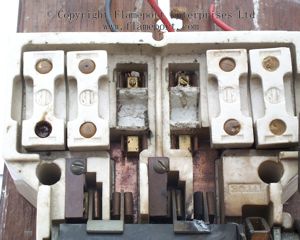 Here, two of the ceramic fuses have been removed. Note the white pads which are probably asbestos.
Here, two of the ceramic fuses have been removed. Note the white pads which are probably asbestos.
The fuse on the left has signs of overheating on the lower screw, as the screw cover has melted. Most of the other screw covers (brown dots) are damaged. If these fall out, the live screws behind are exposed.
The isolator switch is shown in the ON position.
Switch contacts
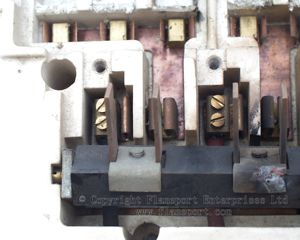 The isolator switch is a spring loaded 'knife' style. Operating the handle tensions a spring, which then quickly moves the blades in/out of the contacts in the base. The double screw terminals are where the incoming supply wires are conncted.
The isolator switch is a spring loaded 'knife' style. Operating the handle tensions a spring, which then quickly moves the blades in/out of the contacts in the base. The double screw terminals are where the incoming supply wires are conncted.
The contacts on the right have suffered from significant overheating which has discoloured the terminals and the switch blades. This is not surprising as the assembly is rated to 30A, yet was supplying 3x 15A circuits which were connected to all of the socket outlets in a large 4 bedroom house.
Back view
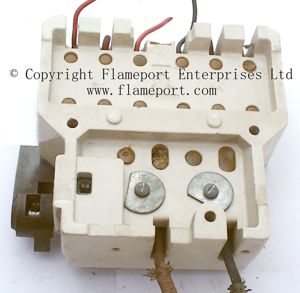 The base is made from a cast ceramic material, with bolts to secure the various items to the front. Most of the bolt holes have been sealed and insulated. The two larger bolts/washers hold the switch mechanism in place.
The base is made from a cast ceramic material, with bolts to secure the various items to the front. Most of the bolt holes have been sealed and insulated. The two larger bolts/washers hold the switch mechanism in place.
Equipment of this age was normally mounted on a separate wooden baseplate, as can be seen in the previous photographs.
Fuses
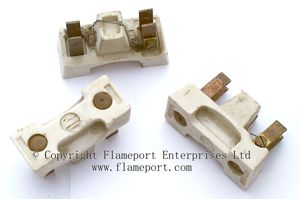 Fuses, made from the same ceramic material. A piece of fusewire is secured between the two terminals. Remarkably, the fuse wire was actually the correct size.
Fuses, made from the same ceramic material. A piece of fusewire is secured between the two terminals. Remarkably, the fuse wire was actually the correct size.
